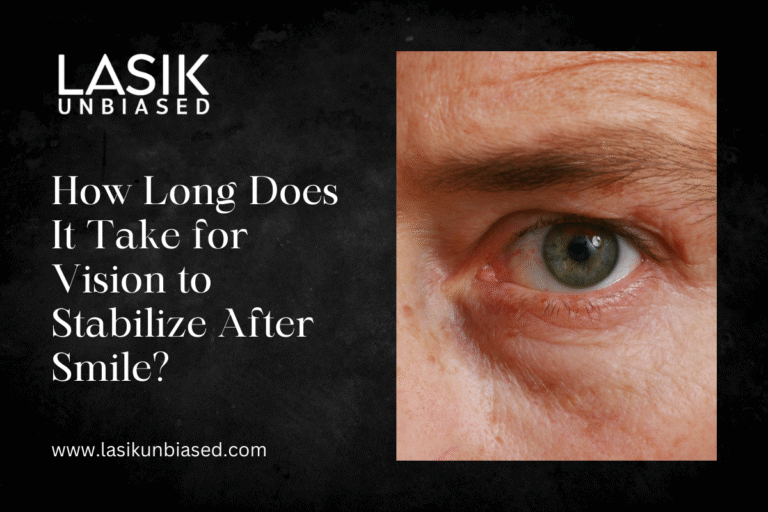Vision typically stabilizes within a few weeks to a month after undergoing SMILE surgery. However, individual recovery timelines can vary depending on factors such as healing rates, adherence to post-operative care, and initial vision irregularities.
Small Incision Lenticule Extraction (SMILE) is a cutting-edge refractive surgery that has transformed the field of vision correction. If you’ve just undergone the procedure, you’re probably eager to understand how soon your eyesight will stabilize and when you’ll enjoy the full benefits. This blog breaks down the timeline, recovery factors, and what to expect after SMILE.
Initial Vision After SMILE Surgery
Your vision might seem clear immediately after the procedure, but this clarity often fluctuates in the first 24 to 48 hours. Most patients experience haziness or mild blurriness during this period, which is completely normal.
Why Immediate Clarity May Not Be Permanent?
- Corneal Healing: Although the SMILE incision is small, the cornea still needs time to heal. This can temporarily affect vision sharpness.
- Eye Hydration: The mild dryness that often occurs post-surgery may impact clarity.
- Neural Adaptation: Your brain also adapts to the changes in vision, which can take several weeks for some individuals.
Day 1 to Day 3 Post-Surgery Expectations
- Expect to see noticeable improvements in how clearly you perceive objects during the first few days.
- Some discomfort, such as mild irritation or sensitivity to light, is common but temporary.
When Vision Starts to Stabilize?
For most patients, vision stabilizes significantly in the first one to two weeks after SMILE. You’ll find that your ability to focus improves steadily, but the complete stabilization process can take up to a month for many people.
Typical Timeline for Vision Improvement
- Week 1 to Week 2:
- Roughly 80-90% of vision clarity is achieved within the first 10 to 14 days.
- Activities such as reading and watching screens will likely feel more comfortable.
- Week 3 to Week 4:
- Small fluctuations in clarity may still occur, particularly under dim light or after prolonged screen use.
- Most patients feel confident enough to resume regular routines, including exercise and driving.
Factors Influencing Stabilization Time
While a general timeline applies to most patients, some individual factors might lead to quicker or slower stabilization:
- Pre-Surgery Prescription
Those with mild refractive errors may recover faster compared to individuals with higher prescriptions.
- Healing Rate
Genetic predispositions and overall eye health play significant roles in recovery speed.
- Post-Surgical Care
Proper adherence to care routines, such as lubricating drops and avoiding eye strain, can accelerate stabilization.
What Fluctuations Are Normal During Recovery?
After SMILE, it’s common to experience subtle variations in visual clarity as the eye adjusts and heals. These will diminish as the recovery phase progresses.
Temporary Symptoms You May Notice:
- Mild Blurriness in low-light conditions or at night, particularly with glowing objects like streetlights.
- Dryness-Induced Haze that affects focus but is easily managed with lubricating drops.
- Halos or Glare, typically diminishing within the first month.
When To Speak With Your Surgeon?
Although fluctuations are normal, reach out to your clinician if symptoms such as severe pain, prolonged blurriness, or redness persist beyond standard recovery times.
Role of Post-Surgical Care in Stabilizing Vision
Proper post-operative care is crucial for achieving the best results and ensuring a smoother, faster recovery. Attending follow-up appointments allows your surgeon to closely monitor your healing progress and address any specific concerns that may arise during your recovery journey.
Recommended Dos and Don’ts
Do:
- Use prescribed medications like antibiotic and anti-inflammatory drops to facilitate the healing process.
- Take care to rest your eyes and avoid straining them during the first week.
- Maintain regular follow-up appointments to effectively track progress.
Don’t:
- Rub your eyes, as this may interfere with healing.
- Expose your eyes to direct water, such as in swimming pools, during the early weeks.
- Skip wearing sunglasses outdoors, as your eyes will be more sensitive to light during recovery.
Long-Term Vision Stabilization After SMILE
Although vision stabilizes for most patients within the first month, minor enhancements may still occur over time. Your final vision clarity might not fully manifest until the three-month mark, when the healing process is completely finished.
Potential Long-Term Adjustments:
- Residual Refractive Errors
On rare occasions, a slight touch-up may be required to fine-tune visual outcomes.
- Continued Adaptation
Ongoing neural adaptation may lead to gradual, subtle improvements in the way your brain processes visual information.
Comparing Recovery Timelines Across Refractive Surgeries
SMILE often boasts faster recovery compared to traditional procedures like LASIK due to its less invasive approach:
- SMILE Recovery
Stabilization in 2-4 weeks, minor symptoms at night.
- LASIK Recovery
Stabilization in 4-6 weeks, with potential for slightly more significant fluctuations.
Monitoring Vision After Stabilization
While your vision will settle after the typical recovery period, monitoring eye health over the long term remains important. Regular eye exams ensure that any potential issues, like dryness or refractive changes, are diagnosed and managed promptly.
Key Tips for Long-Term Eye Health:
- Maintain a balanced diet rich in nutrients like omega-3s and vitamins A, C, and E.
- Avoid excessive screen time or use blue-light filtering glasses if prolonged usage is unavoidable.
- Stay vigilant about annual eye check-ups to detect changes early.
Your Vision After SMILE
SMILE offers life-changing clarity and convenience to patients with refractive errors. While each recovery experience is unique, the vast majority of patients are thrilled with their results within one to two months.
Why Recipients Love SMILE?
- Minimally invasive procedure with faster stabilization periods.
- Safe and effective outcomes for a wide range of prescriptions.
- Reduced risk of long-term side effects compared to other surgical options.
Take the Next Step Toward a Clear Vision
Investing in SMILE means opening the door to a future free of glasses and contact lenses. If you recently underwent the procedure, remember that stabilization is just a matter of patience and proper care.
For those considering SMILE, consult a trusted eye care professional to assess your suitability for this innovative vision correction option. Clear vision is closer than you think!


